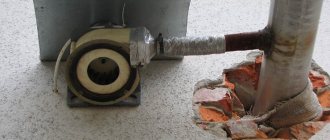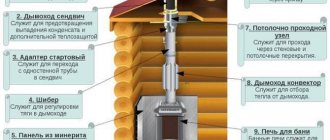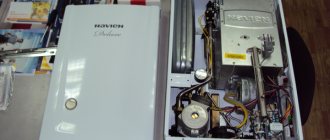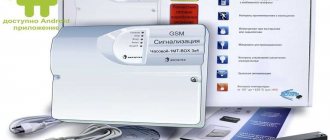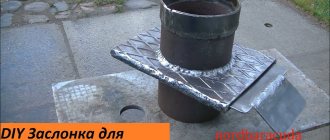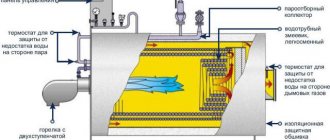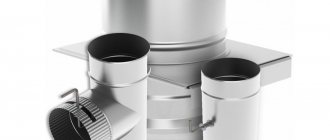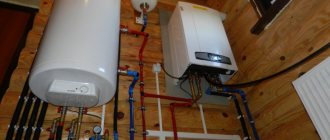Previously, draft and blower fans were used only in industrial boiler installations. The first ones are placed inside the chimney channel and create a vacuum, the second ones pump air into the firebox. Gradually, the units migrated to the domestic sphere - manufacturers began to equip heaters with a closed combustion chamber with turbines. The idea was picked up by home craftsmen, because a smoke exhauster for a boiler helps solve the problem of poor draft in the chimney pipe. Let's figure out whether forced exhaust of combustion products is always necessary.
Purpose of the smoke exhaust device
In a nutshell, installing a smoke exhauster is the simplest way to increase the thermal output of a firebox by increasing the flow rate and volume of flue gases pushed through the chimney.
What does it give:
- the amount of fresh air entering the boiler furnace increases;
- fuel burns more intensely - more heat is released;
- You can burn low-quality fuel, for example, fuel oil, firewood or briquettes with high humidity, frozen coal with ice or snow residue.
Due to the forced blowing of hot gases into the pipe, the efficiency of the boiler is greatly reduced, so the use of a smoke exhauster is resorted to only in cases where circumstances require it. For example, when igniting a boiler, or if you urgently need to warm up the premises of a country house.
In the era of steam locomotives, a direct-flow smoke exhauster was used in the furnaces for a solid fuel boiler, thanks to which the power of the steam engine briefly increased by almost 20-30%. In order to sharply increase the temperature of the water in the boiler, part of the hot steam under pressure was “shot” into the chimney, thereby accelerating the flue gases and artificially increasing the draft in the chimney. The effect was so strong that it was equivalent to a twofold increase in burning coal in the firebox.
Connecting a solid fuel boiler to the system
After the installation of the solid fuel boiler with your own hands is completed and the chimney is in its place, you can proceed directly to connecting the equipment to the general system.
The main thing to remember is that cold water should not be supplied to a working boiler, especially if it has a cast-iron heat exchanger. Otherwise, due to the temperature difference, sticky condensation will form on the walls of the firebox, which will mix with soot. It will reduce the efficiency of the boiler, and it is quite difficult to clean it. In this regard, the requirements for installing a solid fuel boiler provide a standard piping scheme with a bypass and a three-way valve. It is set to a fixed temperature of 50-55º, so that the coolant will move in a small circle until its temperature reaches the required values, after which the valve will begin to gradually dilute it with a cold flow from the heating circuit.
It is worth noting that when piping pellet boilers, special attention should be paid to connecting the burner and automation. Often, products of European brands are equipped with automatic fire extinguishing systems connected to a central water supply
Therefore, in order to figure out how to properly install a solid fuel pellet boiler, you should consult with a representative of the manufacturer.
To connect the boiler, you will also need to install an expansion tank, shut-off valves and a circulation pump. After this, the circuit is filled with water and a pressure of 1 bar is pumped into it. Upon completion of work, a test run of the system is performed to check the functionality.
Design and principle of operation
The design of a smoke exhauster can be judged by its name. The device works to extract flue gases (hence the smoke exhauster) from the lower section of the chimney, throwing them up the channel. This creates a vacuum or a zone of low pressure above the combustion chamber of the boiler, and fresh air is sucked into the firebox.
If the firewood or coal is damp, the fuel is quickly freed from moisture and burns more steadily. A properly selected smoke exhauster stabilizes the combustion front of any fuel, so the burnout depth is quite high - there is less underburning in the boiler furnace.
The design of a standard device consists of five parts:
- impeller or bladed centrifugal wheel (made of heat-resistant stainless steel);
- drive unit. More often it is an electric motor with a control panel and an impeller rotation speed regulator. In addition, a blade drive powered by wind energy can be used;
- frame. Depending on the design, it can be made in the form of a box, “mushroom”, or snail;
- a base plate is used if the design does not include a housing. Used for assembling parts of the smoke exhauster and mounting the device on the boiler chimney.
The engine is connected to the impeller or centrifugal wheel by an intermediate shaft on a bearing with a compensating clutch. This scheme allows you to unload the rotor and block heat from heating the rotating blades of the smoke exhauster.
Branded models of smoke exhausters have thermal insulation and noise insulation, an overheating sensor that turns off the engine when the temperature of the flue gases in the boiler is high. The most “advanced” models use electronic control of the boiler smoke exhauster. The rotation speed of the impeller is adjusted by the control unit to the selected fuel combustion mode.
Step-by-step instruction
Scheme of a single-suction smoke exhauster.
To begin with, it is worth preparing the material according to the appropriate dimensions. All of them must be prepared in advance according to the drawing. It's worth starting with a snail. By the way, it is quite difficult to do it yourself, so the unit can either be ordered or taken from an old engine. The main thing is that its dimensions are optimal and can provide the required performance for air removal. A steel mesh will be attached to the snail. It is installed using a metal ring that presses it to the body. According to the size, it is necessary to drill holes both in the snail itself and in the metal ring. Next you need to prepare the engine for installation. It will be bolted to the volute. Here you will have to try to drill several holes in the metal case. 6 pieces will be enough.
The motor itself will be powered by single-phase voltage. No one should have any problems connecting here. As a rule, such a unit has an output in the form of a cable, which will be connected to the outlet. Some models can be equipped with three-phase units. In this case, you will have to connect the electricity cable yourself. Typically, the cable consists of four cores. Three of them are phases, and the fourth is grounding. Here, too, no one should have any problems with the connection.
As for attaching the engine to the frame, you need to prepare the technological holes in advance. Moreover, they must correspond to the size that is installed on the engine. In the metal plate that will act as the frame, it is necessary to drill using a drill. This is done extremely simply. By the way, it is better to start the assembly itself with the engine.
Schematic diagram of the smoke exhaust unit.
When all the parts are prepared, you can begin assembling the smoke exhauster. Everything is done extremely simply. First you need to secure the engine to the frame. This is done using a bolted connection. For more reliable fastening, the nut and bolt should be tightened using open-end wrenches. When everything is ready, you can start assembling the snail. Here you should perform a set of primitive actions. To begin with, a mesh and a metal plate are attached to the front. It will press the mesh against the surface of the cochlea. Here it is best to use a collapsible bolted connection. All bolts are tightened using a wrench. For assembly, first a mesh is placed on the snail, and then a metal sheet is put on. This is what is tightened with bolts. When this stage of work is completed, you can begin further installation. It will consist of installing an impeller on the motor shaft. There must be a rigid fastening here. Otherwise, the wheel may simply not sit in its rightful place or spin out of alignment with the shaft.
To fit it, it is best to use a keyed connection. To do this, a recess must be provided in the shaft. The same size hole should be on the wheel. Now you can connect the parts into a single whole. All that remains is to insert the wheel into the volute and mount it together with the engine directly to it. It is better to do this using a bolted connection. As noted earlier, to create better rigidity, fastening should be done using open-end wrenches. Now we can state the fact that the work is almost complete. All that remains is to connect three-phase voltage to the motor.
This is done extremely simply.
Device of a “cold” smoke exhauster.
Here you can see several bolts, or rather, there will only be three of them here. Each of them serves to connect a phase. A protective ground is installed on a separate bolt. Without closing the lid, you need to test the unit to determine the correct direction of rotation. If it turns in the wrong direction, then you just need to switch two phases, that is, swap two wires. Now you can safely close the lid.
Next, the tightness of all connections is checked.
After all, it is very important that dirty exhaust air does not escape back into the room. If necessary, a special sealant can be used to eliminate cracks
Fortunately, no one should have any problems buying it. All cracks and holes are sealed with sealant. Only after this can you make a test run to test the smoke exhauster in action.
If you bring your hand to it, air should be drawn in. If this is the case, then everything should work normally, and accordingly, you can put the device into operation.
Technical characteristics and calculation of parameters
On the heating engineering market you can find many models of smoke exhausters of various designs, with different configurations of the body and smoke channel. For the average consumer, units designed for domestic heating boilers are of interest.
Such designs differ from industrial and semi-industrial models in several characteristics:
- the diameter of the chimney channel on which the smoke exhaust fan is planned to be installed is 140-200 mm;
- additional pumping of flue gases through the volute - 150-300 m3/h;
- The weight of the device does not exceed 5-6 kg.
To install the smoke exhauster on a chimney pipe, no additional fixtures or brackets are required. It is enough to buy a heat-resistant sealant, a couple of clamps and stock up on an angle grinder with a cutting wheel for metal.
| Chimney diameter | 140-180 mm |
| Flue gas performance | 235 m3/h |
| Power consumption | 32 W |
| Weight | 4.5 kg |
| Material | Steel, stainless steel |
| Ability to adjust performance | 10-100% |
| Operating gas temperature | 250 ℃ |
| Supply voltage | 230 V |
How to evaluate or calculate the required parameters of a smoke exhauster
To select a specific model, in addition to the pipe diameter, you will need two basic characteristics. These are flue gas temperature and volumetric capacity.
For different boiler units, the temperatures of the combustion products leaving the furnace vary greatly. A gas boiler has an output of only 120-130 ℃, while a wood-burning firebox using birch wood can reach 250 ℃. The highest flue gas temperature is found in a coal boiler. When working on briquettes or anthracite – up to 300 ℃. In addition, coal combustion products produce a high content of sulfur dioxide, which means you need to choose a smoke exhauster with a body and impeller made of corrosion-resistant steel.
Next, it is necessary to determine the performance of the smoke exhauster in terms of flue gases, based on the fuel consumption of the boiler. If there is no reliable data on how much fuel is burned in kg/h, then it will be necessary to recalculate the thermal power of the boiler into fuel consumption.
For example, with a design power of 18 kW/h (taken from the passport), the boiler must consume coal in an amount of at least 3-3.5 kg/h. To burn 1 kg of low-ash coal fuel, at least 9 m3 of air will be required, for dry firewood - 5 m3. As a result, it turns out that when 1 kg of coal is burned, about 10 m3 of flue gases are released, from 3.5 kg - 30-35 m3. Taking into account the efficiency of the furnace, the volume of hot combustion products will be at least 40 m3.
The flow rate through the exhaust fan should be at least twice as large, so the final theoretical productivity of the device should be at the level of 80 m3/h.
The calculation performed is theoretical, since the volume of combustion products depends on the furnace design, operating mode and fuel quality.
Prices: summary table
| Model | Power | Weight, kg | Cost, rub. |
| WPA 120, Poland, M+M | 83 W, for boilers up to 60 kW | 2,1 | 4 800 |
| NWS-100, Poland | 80 W, for boilers up to 50 kW | 2,0 | 4 620 |
| DP-120, Poland, KG Elektronik | 90 W, for boilers up to 60 kW. | 2,1 | 5 660 |
| RR 152-3030 LH, Poland, M+M, developer – Germany, EBM. | 44 W, for boilers up to 30 kW | 1,0 | 6 000 |
Varieties
In addition to choosing the characteristics of the smoke exhauster, it is necessary to choose a design. The devices differ in the method of fastening, the pattern of selection and injection of flue gases into the pipe.
Some models require the installation of a full chimney, but there are also types of overhead smoke exhausters that allow the boiler to operate without an exhaust pipe. As a rule, these are closed fireboxes using gas or wood, operating with fan air supply and removal of combustion products through a coaxial pipe in the wall of the room.
Natural draft enhancers
In order to improve the operation of the chimney, it is not necessary to embed the fan into a sandwich pipe or wall it up in brickwork. There are options for traction amplifiers that are installed at the end of the pipe. Some models have an unusual appearance, but if installed correctly, they can provide an increase in natural draft by 10-15%, provided there is a breeze of at least 3-4 m/s.
The design consists of two shells formed from thin vane blades. One of them is external, looks like a flattened sphere, the second is made in the form of a paddle wheel and is located inside the traction amplifier. Both shells are rigidly fastened to each other and mounted on the axis of rotation. If the device is blown by even a slight breeze, then inside the “dome” there is an area of rarefied pressure, due to which the draft in the chimney increases noticeably.
Simpler designs work on the principle of a Venturi tube. The air flow flowing around the nozzle also reduces the pressure above the pipe cut, which improves draft and, ultimately, the operation of the boiler furnace.
The amplifiers do not have a motor, so the design is reliable, all-weather and maintenance-free. With the exception of severe frosts, when ice freezes on the outer surface from warm water vapor. The disadvantages are considered to be low efficiency and uneven increase in thrust.
If desired, the nozzle can be replaced with a smoke exhaust fan with a coaxial input. The basis of the device is also a centrifugal wheel with an electric motor. The direction of entry into the impeller coincides with the axis of rotation of the exhaust fan impeller. The combustion products are released along the perimeter of the impeller.
Such a device is installed on the cut of the boiler pipe, and an electric cable with a 220 V power supply must also be connected there. This scheme has one drawback - to service or repair the boiler’s smoke exhauster, you need to go up to the roof. Otherwise, this is an almost ideal option:
- the noise from the operation of the smoke exhauster is not heard inside the house;
- vibrations do not reach the boiler;
- The impeller operates with relatively cold flue gases.
The service life of the smoke exhauster, even when the boiler is fully loaded, depends on the quality of the engine waterproofing, which protects the engine from moisture, condensation and solar ultraviolet radiation.
Flow-through smoke exhausters for boilers
Structurally, they are an engine with an impeller installed inside a stainless steel volute. It is mounted on the boiler chimney, so the size of the fan blades is small. You can cut into both horizontal and vertical sections of a steel sandwich.
Advantages of a direct-flow chimney:
- simple installation on the boiler chimney;
- Easy to remove for repair and maintenance.
Direct-flow smoke exhausters are traditionally used on low-power boilers or for igniting cast-iron apartment fireplaces.
Centrifugal duct smoke exhausters for solid fuel boilers
A special class of devices designed to operate in extreme conditions, at temperatures of 250-300 ℃, high content of tarry substances, abrasive dust and sulfur dioxide in flue gases.
The design of the smoke exhauster is a body made of corrosion-resistant steel, on one of the walls of which an electric motor with a centrifugal impeller is mounted.
Nozzles are welded on opposite edges, with the help of which the device is mounted in the cut between the boiler outlet and the steel chimney pipe.
Due to the slight displacement of the plane of rotation relative to the axis of the pipe, the cross-section of the internal passage is not blocked, therefore, no obstacles are created for the movement of the gas flow, and there are no conditions for the accumulation of dust and soot.
For solid fuel boilers, injection overhead smoke exhausters are also used.
They have a centrifugal fan installed, but unlike the direct-flow circuit, the line of movement of the flue gases turns out to be broken. Used for boilers burning wood, pellets or peat briquettes.
When do you need a smoke exhauster?
Manufacturers of heating equipment equip their products with traction fans due to the increased resistance of the heat exchanger, where gases change direction of movement several times through the flame tubes. The goal is to remove maximum heat from combustion products and increase the efficiency of the boiler installation.
A nuance: the operation of the smoke exhauster in a factory-installed boiler is coordinated with the combustion process and is controlled by an electronic unit. When installing a fan unit on a “brainless” heater, such consistency is excluded; you need to buy an automation unit or adjust the speed manually.
Organize fresh ventilation in the boiler room, and only then think about installing a smoke exhauster
We list the situations when a smoke exhauster will help improve the operation and maintenance of a solid fuel heat generator:
- problems with draft - blowing by the wind, air pockets in the gas duct, many turns, narrowing of the diameter;
- due to the design features, the boiler smokes into the room when the door is opened;
- the height of the chimney is insufficient or the cut of the pipe fell into the wind support zone behind the ridge of the roof or another building;
- Cracks have appeared in the brick pipe, from which smoke is leaking.
Important point. No fan will save the situation if there is no influx from the street in the boiler room. At first, the working impeller will create a slight vacuum, but then the blades will begin to mix the air in place. Supply ventilation is a prerequisite for the normal operation of any heater.
It is better to operate the V. G. Kholmov mine heat generator with a traction fan.
Some designs of wood-burning boilers (for example, shaft type) tend to emit smoke through an open loading hatch. A similar picture is observed in heat generators with a three-pass fire-tube heat exchanger of high resistance. The solution to the problem is to install a traction or blowing machine controlled by a controller.
Strengthening natural draft with the help of a smoke exhauster also has a downside. If, after warming up the pipe, natural exhaust has not been restored, the unit cannot be turned off - you may get burned. Now imagine that in the middle of the night the power supply goes out and the fan stops. While the chain thermostat closes the damper, smoke will fill the boiler room.
Recommendation. The smoke exhauster should not become a panacea. Be sure to take measures to restore draft - repair or alter the flue in accordance with the requirements specified in the boiler instructions.
Advantages and disadvantages
A smoke exhauster is indispensable if you need to quickly light a boiler, or if you have to heat it with damp wood. Until the chimney pipe warms up, there will be no normal draft, which means that smoke and fumes from the firewood will be thrown out of the boiler firebox into the room. When the smoke exhauster is turned on, you can set a small constant flow of air. After 15-20 minutes, the wood chips will flare up, and you can load solid fuel.
The second most important advantage of the joint operation of the smoke exhauster and boiler is the ability to regulate the draft level. As a result, the fuel burns evenly, without overburning, which means it is possible to plan the boiler load and select a comfortable heating level.
The negative aspects of installing a smoke exhauster on a boiler include:
- the presence of noise and vibrations transmitted along the steel walls of the chimney;
- the need to precisely regulate the impeller speed. Otherwise, the efficiency decreases, and some of the heat is irretrievably lost with the flue gases.
In addition, if the boiler runs on coal or substandard wood, the blades will need to be periodically cleaned of soot and tar. Otherwise, the clearance will decrease, dirt will clog the gaps, and the fan blades may jam.
Pyrolysis
The specificity of the operation of pyrolysis boilers for water heating using solid fuel is the use of gas in their operation. It is a product of wood decomposition under conditions of high temperature and lack of oxygen. The design includes two chambers separated by a grate. The upper compartment is intended for burning fuel, and the lower one is for afterburning the resulting gas. First, the fuel enters the upper chamber. After it ignites, the fan turns on.
Upon reaching temperatures of +250 degrees, the process of charring the wood and releasing gas begins. To supply it to the lower chamber, ceramic nozzles are provided. There, gas and air are mixed, which is accompanied by reheating of the ignited fuel mixture in the first compartment. In limited supply mode, the wood gradually decomposes and gasifies. This process is called pyrolysis.
Solid fuel pyrolysis home heating systems have the following characteristics:
- Efficiency up to 90%.
- Good operating time on one fuel fill is up to 10 hours.
- Expensive.
- Energy dependence.
- Requirement to use full downloads.
- The need for high-quality drying of firewood.
Installation features
All that is needed to install a direct-flow smoke exhauster is to cut two holes in the side wall of the chimney pipe. If the chimney is assembled from sandwich-type sections, then the outer shell must be cut to the size of the snail. You can use a grinder or try to cut stainless steel with hand metal scissors.
To install the device on the boiler pipe, you will need to apply heat-resistant automotive sealant (red for manifolds), secure the upper and lower parts of the volute body with heat-resistant steel clamps.
Principle of operation
The main purpose of the smoke exhauster is to pump air masses by rotating a kind of wheel; the flow will gradually be forced towards the center of the structure. After this, it will enter the chamber, and there a vacuum occurs, which leads to the entry of another portion of air into the firebox.
The unit serves to create continuous circulation, this is how this device works. The blades are responsible for the flow of oxygen; they create a directed vortex movement that goes towards the rotor, ensuring a continuous cycle.
At this point, all combustion products are also eliminated along with solid particles and unignited gas, and heat is generated.
Technology and recommendations for self-production
Assembling a smoke exhauster and installing it on a boiler is not as difficult as it might seem at first glance. To do this, you need to buy a 40-50 W motor with a stainless steel impeller and an electronic speed control unit. This is enough for a boiler with a power of up to 18-20 kW.
You can try to make an impeller with your own hands, but from practice it is known that homemade impellers are difficult to balance. During operation, both the smoke exhauster and the steel body of the boiler will hum loudly.
The first step is to make a mounting plate on which we attach the exhaust fan motor and install the impeller.
Until the device is fully assembled, it is difficult to evaluate its performance and compare it with the required characteristics for the boiler.
The second step is to weld the annular body of the smoke exhauster, weld the flue gas exhaust pipe and the front wall with the inlet pipe. After assembly, you can connect the motor to the network and check the performance of the smoke exhauster.
The next step is to place the smoke exhauster housing on the boiler outlet flange. First, we put the device “in the rough” in order to mark on the wall the coordinates of the hole for the exhaust chimney pipe. Then we remove the smoke exhauster from the boiler, punch a hole in the wall with a hammer drill and insert a sandwich chimney.
The last step is to place the smoke exhauster on the boiler, wrap the joint seal with asbestos or basalt cord, and coat it with thermosealant. Next, we join the sandwich with the exhaust pipe of the smoke exhauster, with winding and coating. Only after this can the space in the wall around the pipe be sealed with asbestos-cement mortar. After a day, you can start the boiler and try the smoke exhauster in operation.
All that remains is to select the optimal engine speed.
How to make an exhaust unit
The main difficulty in assembling a smoke exhauster with your own hands is making a balanced impeller; the remaining parts are not difficult for a home craftsman who knows how to weld. If the impeller blades vary in weight, normal fan noise will turn into rumble due to vibration.
In addition to the blades, you will need the following elements:
- electric motor with a power of up to 150 W, maximum shaft speed – 1400 rpm;
- snail or homemade box shown in the drawing;
- a shaft with ventilation holes or an additional cooling impeller;
- studs with M8 nuts and other fasteners;
- power cable.
We offer ordinary homeowners the least thorny path - buy a factory electric motor with an impeller and a cooling impeller, weld the box and assemble a fully functional duct smoke exhauster for a TT boiler. How to do this correctly, watch the video.
How to connect it to the mains voltage.
The smoke exhauster is connected through a thermostat, which controls the temperature of the coolant leaving the boiler and periodically turns on the smoke exhauster when the coolant temperature drops, and then turns it off when the set temperature is reached.
The smoke exhauster can be connected through the standard boiler control unit when replacing the blower fan with a smoke exhauster, if their powers are the same.
If the power of the smoke exhauster is greater, then the electrician must connect it through a contactor of the appropriate power. If such a unit is not available, you must purchase a device that is available from our company.
Connecting the electric motor.
The power cable must be connected using cable lugs only. Use cable lugs of the appropriate cross-section to prevent overheating of the cable connection to the winding terminals. The cable to the terminal box must be connected without tension, and the contact connections must be securely tightened.
Motor protection.
Each electric motor must be protected against overload and short circuit. The settings of the protection devices must correspond to the operating mode of the electric motor, as well as its characteristics.
Short circuit protection is carried out using fuses or circuit breakers (the second option is more preferable, as it eliminates the occurrence of a “phase loss” mode). When choosing an automatic machine, it is necessary to take into account that the starting current of an asynchronous electric motor with a short-circuited winding is 5–7 times higher than the rated one.
Thermal protection must be time-delayed and can be achieved using a thermal relay.
If the engine has built-in temperature sensors, they must be connected.
Attention! Short circuit protection must be implemented in any case, regardless of whether there is built-in temperature protection or not.
Electric motor maintenance.
1. Checking the degree of contamination of the outer surface.
As well as the fan and engine protective casing. If the housing is dirty, remove the dirt using a rag or soft brush. Use compressed air to remove dust or chips from the surface of the engine, as well as from the ventilation unit.
2. Checking the temperature of the bearing units and motor housing.
3. Checking the vibration level of electric motor components.
If you have the appropriate measuring instruments, perform vibration diagnostics of the engine bearing units to determine their technical condition and make a decision on repairs.
4. Check the degree of wear of the shaft seals.
While the engine is stopped.
5. Checking the motor insulation resistance.
While the engine is stopped.
6. Check the tightness of all bolted connections.
Including the connection of the power cable and motor terminals (first make sure that there is no voltage applied to the motor).
7. Visual external inspection of bearing units.
Make sure there are no grease leaks.
Can an electric motor burn out?
If it can burn, then why?
The smoke exhauster has an asynchronous motor, which can be connected to a 220 or 380 Volt network.
It is connected to a 380 V network by a star, and to a 220 V network through a capacitor of the appropriate rating (which depends on the engine power) by a specialist electrician. The connection to the 380 V network must comply with the requirements of the “Operation Manual for Asynchronous Motors”.
To prevent the electric motor from burning out during operation, it is necessary to install protection against overload and short circuit.
The settings of the protection devices must correspond to the operating mode of the electric motor, as well as its characteristics. Short circuit protection is carried out using fuses or circuit breakers (the second option is more preferable, as it eliminates the occurrence of a “phase loss” mode). When choosing a machine, it is necessary to take into account that the starting current of an asynchronous electric motor is 5–7 times higher than the rated one.
Thermal protection must be time-delayed and can be achieved using a thermal relay.
The use of “cheap” contactors for switching on, which are characterized by “sticking” of the contact in one of the phases, is the reason for the combustion of the electric motor during operation.
The operating instructions for asynchronous motors used on BAGAN smoke exhausters are posted in the documentation section at the link.
